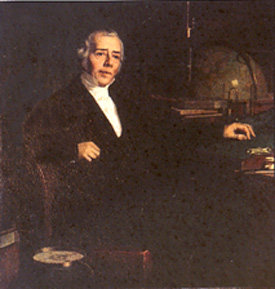Two-day conference to explore Oersted and the Romantic influences on scientific achievement
Scientist-‘Romantic’ sparks interest

While giving a lecture in 1820 at Copenhagen University, scientist-philosopher Hans Christian Oersted held an electric wire over a compass and switched on the current. What happened next changed the way we live, brightening our nights and making our days less laborious.
Different versions of the story exist, but all agree that Oersted saw the compass needle move that day in 1820 and was the first to understand that the electric current creates a magnetic field in its vicinity.
That simple act by a then-obscure Danish scientist sparked a slew of discoveries leading to the development of the electric motor, the electric generator, and, according to Gerald Holton, Mallinckrodt Professor of Physics and professor of the history of science emeritus, to the beginning of the second Industrial Revolution.
Moreover, Oersted’s find has also had a great impact on future generations of scientists and engineers. Oersted’s linkage between electricity and magnetism was the first step toward the Holy Grail of physics, the unification of the known forces in the universe, a mission that today is still pursued by scientists around the world.
The names of those who built on Oersted’s discovery are now famous. Andre-Marie Ampere immediately began working to formulate the mathematical laws of electromagnetism, and Michael Faraday discovered that changing magnetic fields could be used to create electric current in a wire.
“Ampere, Faraday, and others at the time were immediately influenced by him,” Holton said, “leading to motors, generators, and electric lights…. [But) he is practically invisible in America.”
Oersted was prepared to make his critical observation, Holton said, by the complex mix of philosophical, religious, and aesthetic ideas of the Romantic era in which he had steeped. That framework, evidenced by his dissertation at Copenhagen University on the metaphysics of German philosophers – who had preached on the unity of all nature’s forces – readied him to see what had escaped all others.
The Danish are rightly proud of Oersted, considering him second only to physicist Niels Bohr, but even scientists today know little about him. Holton has been working to remedy that, first by convincing Princeton University Press in 1998 to publish the first English translation of Oersted’s scientific papers from the Danish original.
On May 10 and 11, the latest efforts of Holton and a committee of his colleagues in the History of Science Department will bear fruit with a two-day conference on Oersted, his times, and his philosophical background, “International Symposium on H.C. Oersted and the Romantic Legacy,” at Harvard’s Science Center, lecture hall C.
The conference is sponsored by Harvard’s History of Science Department, the Program in Science, Technology and Society at the Massachusetts Institute of Technology, and the Royal Danish Consulate. The symposium will bring together some 30 international experts in science, philosophy, religion, experimental instrumentation, and of Oersted’s links to France and England.
While Oersted will be a jumping-off point, panelists will discuss Danish society, 19th century Romanticism, the influence of philosophers such as Immanuel Kant and the Nature Philosophers – all important influences on Oersted, his peers, and his followers. Looking at Oersted’s work from a societal and cultural perspective, rather than solely a scientific one, will open up a greater understanding of the thoughts and work of those 19th century scientist-philosophers, Holton said, because few scientists have escaped the influence of the culture of their time.
Holton cited as an example the prominence of biologists today, whose predecessors, he said, were often relegated to obscure laboratories. The change, he said, has come as our society has increasingly come to regard good health as a human right and directed research funds to the understanding of biology and medical science and technology.
Son of a pharmacist
Oersted was born in 1777, the son of a pharmacist. After attending Copenhagen University, he won a travel scholarship in 1801. He spent three years in Germany and France, becoming deeply enchanted with the then-pervasive cultural and intellectual movement known as Romanticism.
After his discovery, he continued working until his death in 1851, conducting experiments on the compressibility of fluids, becoming the first to produce pure aluminum, and writing on philosophy and literature. One biography credits him with encouraging his friend, the writer Hans Christian Andersen, to produce fairy tales.
“The audience of the symposium can expect to hear from and discuss with the distinguished speakers about this striking example of the fruitful interaction of science and the greater culture, which nowadays is rarely attended to but which is all around us,” Holton said. “And it will also give us a chance to look at that important point in history when Western civilization began to move into the new electric age in which we now live.”
For additional details on the Oersted symposium, which is free and open to the public, see the Gazette Calendar section and the Web page: http://www.fas.harvard.edu/hsdept/intro/oersted.html




